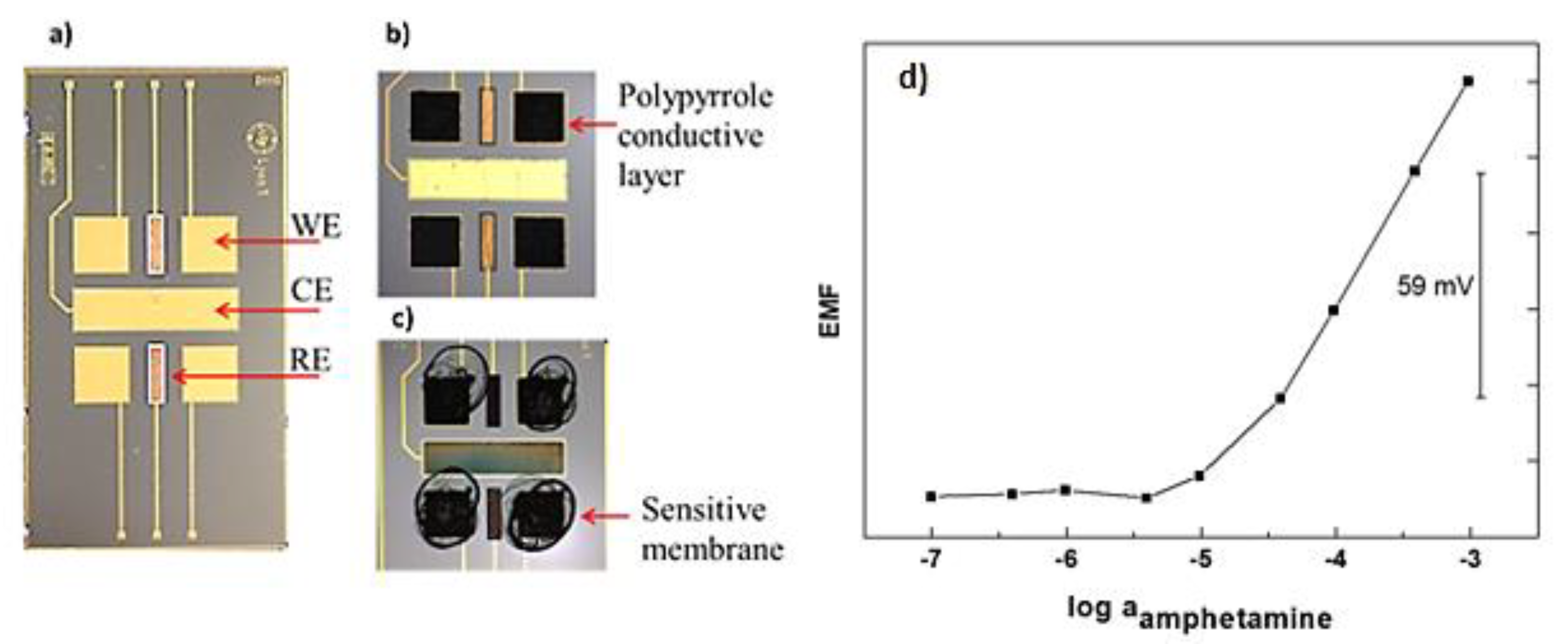A Highly Sensitive Potentiometric Amphetamine Microsensor Based on All-Solid-State Membrane Using a New Ion-Par Complex, [3,3′-Co(1,2-closo-C2B9H11)2]− C9H13NH+ †
Abstract
:1. Introduction
2. Materials and Methods
2.1. Preparation of [C9H13NH]+[3,3′-Co(1,2-closo-C2B9H11)2]−
2.2. Sensitive Membrane
3. Results and Discussion
3.1. The Ion Par Complex [C9H13NH]+[3,3′-Co(1,2-closo-C2B9H11)2]−
3.2. Sensor’s Respons Characteristic: Potentiometric Measurements
3.3. Selectivity
4. Conclusions
Author Contributions
Acknowledgments
Conflicts of Interest
References
- European Monitoring Centre for Drugs and Drug Addiction. European Drug Report 2016: Trends and Developments; Publication Office of the European Union: Luxembourg, 2016. [Google Scholar]
- European Monitoring Centre for Drugs and Drug Addiction and Europol. EU Drug Markets Report. In-depth Analysis; EMCDDA-Europol Joint Publications, Publications Office of the European Union: Luxembourg, 2016. [Google Scholar]
- European Monitoring Centre for Drugs and Drug Addiction. Assesing Ilicit Drugs in Wastewater: Advances in Wastwater-Based Drug Epidemiology; Publication Office of the European Union: Luxembourg, 2016. [Google Scholar]
- Castiglioni, S.; Thomas, K.V.; Kasprzyk-Hordern, B.; Vandam, L.; Griffiths, P. Testing wastewater to detect illicit drugs: State of the art, potential and research needs. Sci. Total Environ. 2014, 487, 613–620. [Google Scholar] [CrossRef] [PubMed]
- Gallardo-Gonzalez, J.; Baraket, A.; Bonhomme, A.; Zine, N.; Sigaud, M.; Bausells, J.; Errachid, A. Sensitive Potentiometric Determination of Amphetamine with a Micro Ion-Selective Electrode. Anal. Lett. 2017. [Google Scholar] [CrossRef]
- Graniczkowska, K.; Pütz, M.; Hauser, F.M.; de Saeger, S.; Beloglazova, N.V. Capacitive sensing of N-formylamphetamine based on immobilized molecular imprinted polymers. Biosens. Bioelectron. 2016, 92, 741–747. [Google Scholar] [CrossRef] [PubMed]
- Plesek, J.; Base, K.; Mares, F.; Hanousek, F.; Hermanek, S. Potential Uses Of Metallocarborane Sadnwich Anions For Analysis, Characterization And Isolation Of Various Cations and Organic Bases. Collect. Czech. Chem. Commun. 1983, 49, 2776–2789. [Google Scholar] [CrossRef]
- Saxberg, B.E.H.; Kowalski, B.R. Generalized standard addition method. Anal. Chem. 1979, 51, 1031–1038. [Google Scholar] [CrossRef]
- Bakker, E.; Pretsch, E.; Bühlmann, P. Selectivity of Potentiometric Ion Sensors. Anal. Chem. 2000, 72, 1127–1133. [Google Scholar] [CrossRef] [PubMed]

| Parameter | Amphetamine Selective Microsensor |
|---|---|
| Slope (mV/decade) | 60.1 |
| Limit of detection (M) | 1.2 × 10−5 |
| Time of response (s) | <10 |
| Interference | KIJPot |
|---|---|
| N-formyl amphetamine | −2.15 |
| Methylbenzylamine | −2.09 |
| Phenylalanine | −2.09 |
Publisher’s Note: MDPI stays neutral with regard to jurisdictional claims in published maps and institutional affiliations. |
© 2017 by the authors. Licensee MDPI, Basel, Switzerland. This article is an open access article distributed under the terms and conditions of the Creative Commons Attribution (CC BY) license (https://creativecommons.org/licenses/by/4.0/).
Share and Cite
Gallardo-Gonzalez, J.; Baraket, A.; Boudjaoui, S.; Clément, Y.; Alcácer, A.; Streklas, A.; Teixidor, F.; Zine, N.; Bausells, J.; Errachid, A. A Highly Sensitive Potentiometric Amphetamine Microsensor Based on All-Solid-State Membrane Using a New Ion-Par Complex, [3,3′-Co(1,2-closo-C2B9H11)2]− C9H13NH+. Proceedings 2017, 1, 481. https://doi.org/10.3390/proceedings1040481
Gallardo-Gonzalez J, Baraket A, Boudjaoui S, Clément Y, Alcácer A, Streklas A, Teixidor F, Zine N, Bausells J, Errachid A. A Highly Sensitive Potentiometric Amphetamine Microsensor Based on All-Solid-State Membrane Using a New Ion-Par Complex, [3,3′-Co(1,2-closo-C2B9H11)2]− C9H13NH+. Proceedings. 2017; 1(4):481. https://doi.org/10.3390/proceedings1040481
Chicago/Turabian StyleGallardo-Gonzalez, J., A. Baraket, S. Boudjaoui, Y. Clément, A. Alcácer, A. Streklas, F. Teixidor, N. Zine, J. Bausells, and A. Errachid. 2017. "A Highly Sensitive Potentiometric Amphetamine Microsensor Based on All-Solid-State Membrane Using a New Ion-Par Complex, [3,3′-Co(1,2-closo-C2B9H11)2]− C9H13NH+" Proceedings 1, no. 4: 481. https://doi.org/10.3390/proceedings1040481
APA StyleGallardo-Gonzalez, J., Baraket, A., Boudjaoui, S., Clément, Y., Alcácer, A., Streklas, A., Teixidor, F., Zine, N., Bausells, J., & Errachid, A. (2017). A Highly Sensitive Potentiometric Amphetamine Microsensor Based on All-Solid-State Membrane Using a New Ion-Par Complex, [3,3′-Co(1,2-closo-C2B9H11)2]− C9H13NH+. Proceedings, 1(4), 481. https://doi.org/10.3390/proceedings1040481







